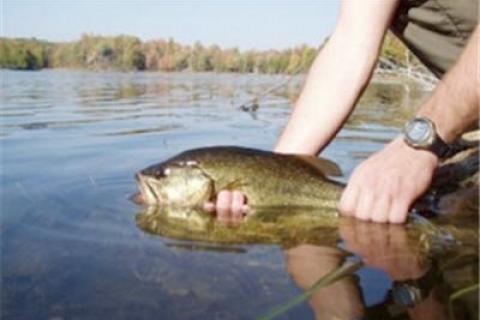
As the late, great Lee Wulff once said, "A good game fish is too valuable to be caught only once."
Catch-and-release fishing has become an effective conservation tool, but the value is diminished if fish do not survive after being released. Unfortunately, it's not enough just to “toss a fish back” after you unhook it. Many fish that are released often die due to wounds inflicted during the catch.
 By adopting a few simple habits, recreational anglers can increase their fish’s chances of being caught another day.
By adopting a few simple habits, recreational anglers can increase their fish’s chances of being caught another day.
Proper Tools of the Catch & Release Method
- Time is a precious resource for a fish’s survival, so try to land your catch quickly. Use a single hook that can be easily and quickly removed. Barbless and circle hooks also reduce the chances of a fish being hooked in the gut or gills, which is often a fatal wound for a fish.
- If you do not have a barbless hook, use needle-nosed pliers to flatten the barbs on existing hooks.
- Here is a great list of catch-and-release tools to assist you in the water.
- It’s best to land a fish by hand, but should it need to be netted, use a rubber or mesh net, not one made with abrasive material. Knotted nets can damage the fins, slice through the skin and rub away the protective coating of fish.
Handling Your Fish
- If possible, always keep fish in the water when removing hooks. This allows the fish to continue getting oxygen and reduces their level of exhaustion from thrashing while out of the water.
- Have your tools nearby to reduce the time spent releasing the fish from your line. Hemostats or long-nose pliers are essential tools in an angler’s arsenal, so have them ready when the time comes to remove the hook.
- When handling a fish, make sure your hands or gloves are wet. This prevents serious damage or infection to the fish’s mucus lining. Avoid handling the belly, as its internal organs can be compromised. Fish should be held by cradling the head and tail.
Releasing It Back to the Water
- Once the hook has been removed, gently acclimate a fish back to the water. Never throw a fish back into its habitat. Hold it upright in the water until it regains composure and swims away under its own strength.
- If you notice the fish is bleeding or seriously injured, consider keeping it for a meal rather than allowing it to suffer or die after being released. Make sure the fish meets any catch regulations where you are fishing before keeping it.
- 4346 views

